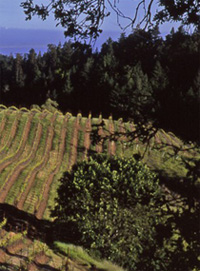 Fort Ross Vineyard strives to produce wine of purity and elegance that reflects the cool maritime climate and challenging terroir of the steep Sonoma Coast Ridges.
Fort Ross Vineyard strives to produce wine of purity and elegance that reflects the cool maritime climate and challenging terroir of the steep Sonoma Coast Ridges.
WINEMAKING: Winemaking begins in the vineyard. To produce truly outstanding wines farming practices must enhance the winemaking. All Fort Ross Vineyard wines are made exclusively with Estate-grown grapes from the Fort Ross Vineyard on the Sonoma Coast. No grapes from other vineyards are brought in even if the yields are greatly lower than usual. There is a constant flow of information between Winemaker, Jeff Pisoni, and Owners/Vineyard Managers, Lester and Linda Schwartz. Each harvest, the three repeatedly walk the vineyard, carefully taste the grapes from each block and harvest the fruit based upon flavor development. Single blocks are often picked several times to guarantee grapes with the desired acid balance and flavor components. To maintain the integrity of the fruit and avoid bruising or oxidation, all bunches are harvested into small picking trays during the cool of the night and then gently transported to the winery in partially filled 1/2 ton macro bins.
WINEMAKING PHILOSOPHY: Winemaker, Jeff Pisoni, seeks to achieve a sense of balance between concentration and elegance. “The fruit lends a certain weight and depth to the wine while the cool climate produces the beauty and elegance”. With minimal winemaking intervention Jeff strives to give the wine a sense of place. “I like to use native yeast for fermentation. Native yeast is from both the vineyard and the winery. The fermentation is slower but the results are more distinctive”. Jeff is very careful in his punch down regimen, constantly monitoring the developing flavors. “Early in the fermentation I punch down more to extract gentle tannins. Later in the fermentation you need to avoid extracting the harder seed tannins”.
FARMING CHALLENGES: Fort Ross Vineyard is the closest vineyard to the Pacific Ocean in California and gets more rain than the Amazon Jungle. The average rainfall is 75” but can reach 125” per year. If it rains before we have finished harvesting we have to abandon the grapes in our steepest blocks. The summers are dry and considered water scarce. Our only source of water is our vineyard pond. We maintain a cover crop of native grasses between the vine rows that helps us gain access into the vineyard in the spring. Each year as the grapes begin to ripen we need to cover each vine with netting to protect the fruit from the flocks of birds as the vineyard is planted in a series of meadows surrounded by thick forests. Farming on the steep coastal ridges requires a great deal of skill. We use wheel tractors in the flatter areas, crawlers on the steeper slopes and walk where it is not safe to use machinery. All harvesting is done by hand.
CHALLENGING TRADITIONAL PROCEDURES: Lester and Linda Schwartz seized the chance of developing a vineyard site less than a mile from the Pacific Ocean despite being mocked by academics who believed that the harsh coastal climate would not ripen grapes while the fog and rain would make the crop constantly vulnerable. To test their theories, they first installed a small trial vineyard with eighteen different varieties of grapes and three different trellis systems. Then they began preparing the first blocks of the main vineyard that took them four years to be ready for planting. They chose rootstock suitable for the soil variations in the vineyard and two years later, when the rootstock was well established, they field grafted the budwood. In the cool coastal climate it took three more years before all the vines in each block were successfully grafted as the grafts need hot weather to callous and grow.
PRUNING: The vineyard was first trained to cane pruning which is more traditional in cool climates. It allows more ‘fruiting potential’ on the vine during pruning by leaving more buds and canes as an insurance against a small crop. Then block by block we began converting the vineyard to cordon pruning in an effort to elevate the wine quality through better fruit balance and more even ripening even though this meant accepting an even lighter crop.